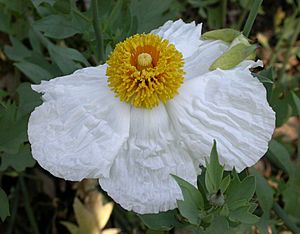Bristly Matilija poppy facts for kids
Quick facts for kids Bristly Matilija poppy |
|
|---|---|
 |
|
| Scientific classification | |
| Genus: |
Romneya
|
| Species: |
trichocalyx
|
The Bristly Matilija Poppy (scientific name: Romneya trichocalyx) is a beautiful flowering plant that belongs to the poppy family. You might also hear it called the Hairy Matilija Poppy. This special poppy grows naturally in parts of California, specifically in San Diego, Ventura, and Santa Barbara counties. It also grows in Baja California, Mexico.
You can often find this poppy in dry canyons. It likes to grow in areas with specific plant groups called chaparral and coastal sage scrub. People love to plant it in their gardens because of its large, eye-catching flowers. It's a popular ornamental plant, just like its close relative, Romneya coulteri.
Contents
Discover the Bristly Matilija Poppy
The Bristly Matilija Poppy is a type of shrub. It can grow to be quite tall, usually between 1 and 2.5 meters (about 3 to 8 feet) high. It grows from a special underground root system called rhizomes. These rhizomes help the plant spread and grow new shoots.
What Does It Look Like?
The leaves of this poppy are a pretty gray-green color. Each leaf is divided into a few parts that look like spear tips. These are called lance-shaped lobes.
The flowers are truly amazing! They are large and grow by themselves, not in a cluster. Each flower has six bright white petals. These petals can be quite big, measuring between 4 and 8 centimeters (about 1.5 to 3 inches) long. In the very center of the flower, you'll see a bunch of bright yellow stamens. These are the parts of the flower that make pollen.
After the flower blooms, it forms a fruit. This fruit is a bristly capsule, which means it's a dry case covered in tiny hairs. It's usually between 2.5 and 3.5 centimeters (about 1 to 1.4 inches) long. Inside this bristly capsule are many tiny seeds, ready to grow into new poppies.
How It's Different from Other Poppies
The Bristly Matilija Poppy is very similar to another poppy called Romneya coulteri. However, there are a few ways to tell them apart. The Bristly Matilija Poppy has sepals (the leaf-like parts that protect the flower bud) that are hairy. Its flowers and fruits are also a bit smaller than those of R. coulteri.
For a while, some scientists thought these two poppies were the same species. But today, most plant experts in California agree that they are two different and unique types of poppies.
Who Was It Named After?
This interesting plant was named in honor of an Irish astronomer named John Thomas Romney Robinson. It's cool how plants can be named after people who did great things in other fields!

